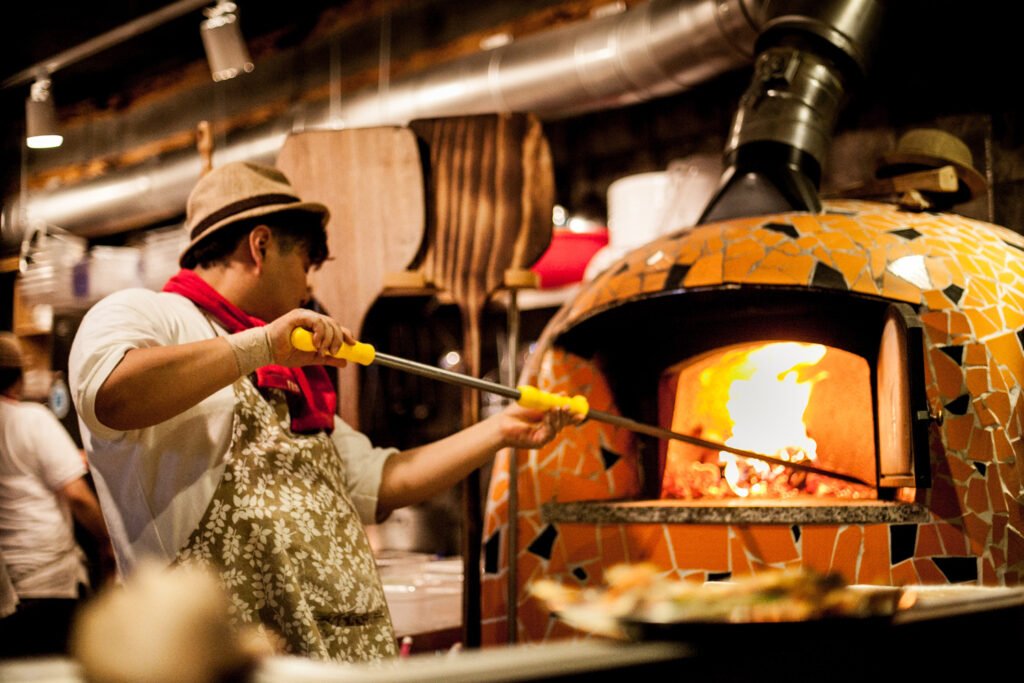Beginner’s Guide to Opening a Profitable Pizza Parlour
Pizza is one of the most popular dishes in the world, both in-home cooking and in restaurants, cafes, and fast food. The first pizza parlour was opened in Naples in 1830 and is still working today, but the explosive growth in popularity of this food occurred after the Italian military campaign of World War II, during which the American and European military got acquainted with Italian cuisine.
Below we will talk about how to open your own pizza parlour from scratch, what equipment you need for it, and how much money, and you can also see an example of a business plan.
What to start pizza parlour business with?

Starting a business in any area, it is necessary to study the relevant market sector: determine the leading directions, the level of supply and demand, competition, and calculate all possible financial costs.
When planning to create your own pizza parlour, you need to immediately decide whether it will be a full-fledged restaurant or whether it makes sense to start only with the preparation and delivery of products.
The second option is optimal for start-up entrepreneurs who do not have significant financial investments: opening a restaurant, you will have to spend more money on the equipment of the hall for clients, pay for waiters, and some other expenses.
Both options provide for the creation of one establishment or an entire network designed to maximize the reach of the target audience.
Sometimes it makes sense to combine both possible ways: in central or crowded sleeping areas, you can open a standard pizzeria restaurant, in those parts of the city where there is not enough target audience, you can place only pizza preparation and delivery points.
Immediately it is necessary to develop the concept of a pizza parlour: pizza can be Italian and American.
If only the production and delivery of dishes is planned, it is better to choose an American one – its thicker crust allows the product to reach the customer hot, while thin Italian pizza cools down very quickly.
Guidelines on opening a pizza parlour
After the main aspects of the business have been thought out, you should draw up a plan for opening a pizza parlour.
When creating a pizzeria from scratch, there are several stages to go through:
Come up with a name. It should be simple, memorable, and preferably associated with the main dish.
Choose a concept. It can be just a delivery cafe or just a cafe.
Create a menu.
Be sure to include the main popular types of pizza and drinks.
You can enable the rest at your discretion.
The easiest way to find out how you can expand the menu is to analyze your competitors.
Make a business plan.
It is necessary to calculate the cost of pizza and the expected profit, the number of investments in starting a business, including one-time, start-up costs, and monthly expenses.
Go through business registration with the tax office.
It can be an individual entrepreneur, LLC, or their analogs in your country.
This item is required for a further official accounting of all expenses.
Rent and renovate the premises.
If the company only deals with the preparation and delivery of pizza, the kitchen equipment, and a utility room with a total size of 40 sq. meters.
When opening a full-fledged pizza parlour, you will have to rent a specialized room for catering facilities with an area of less than 100 square meters.
If the company will offer exclusively pizza delivery, the territorial location of the pizza parlour does not matter.
When opening a restaurant, it is better to choose the central part of the city or a busy sleeping area.
Purchase equipment and furniture.

Depending on whether the production of products will be automated, or many functions are planned to be performed manually, the list of equipment can be modified or expanded.
It is imperative to purchase a table for cutting food, refrigerators, an oven (tunnel or hearth), equipment for making a sauce, kneaders, a pizza table, a press (if necessary), a vegetable cutter, and some other accessories (dishwasher, freezer, etc.).
Obtain the required permits and licenses.
The catering business is very strictly controlled by the regulatory authorities.
The main permit, without which the pizza parlour cannot be opened, is issued by the SES.
This regulatory body makes a lot of regulations and requirements that must be met in strict compliance.
This includes sanitary conditions, and the provision of electricity, heating and water supply.
The fire safety of the future pizzeria must be put in order.
Purchase packaging.

Prices start at around ₽6-7 apiece, depending on size, design, and custom print availability.
The more you buy, the cheaper.
Hire staff. When opening a pizza delivery establishment, the size of the state can be small.
It will take about 2-3 cooks, 2 unskilled kitchen workers, an operator responsible for receiving orders and delivering dishes, as well as employees for delivering orders (preferably with their own vehicle) Do not forget about training bakers, because not all of them know how to make the right dough and bake delicious pizza.
Conduct an advertising campaign.
Due to the high level of competition, a new enterprise should immediately express itself clearly.
The main methods are advertisements on the Internet and in the press, distributing leaflets on the streets, or posting them in specially designated places.
Be sure to create pages on social networks, where you will publish promotions and news of your institution.
Follow competitors on their discounts, and run promotions yourself.
After you have passed all the above steps, you can open a pizzeria, guided by the created concept and preliminary financial calculations.
How much money do you need
First of all, you need to calculate the estimated investment at the beginning of the activity.
Mandatory minimum costs will be:
- rental of premises – depends on the territorial location and area;
- registration with the tax service – individual entrepreneur from $ 800, LLC – from $ 14,000.
- purchase of equipment – from $ 4500, depending on the specifics and scale of work;
- purchase of products – within $ 100,000 at the start and depending on the volume of work of the pizzeria on a monthly basis;
- salary – calculated taking into account the size of the staff and the number of hours worked;
- advertising campaign – from $ 0 at the start. You can find the first clients already among your friends on social networks.
- To do this, just post a post on your page.
As a result, after drawing up an individual business plan, an entrepreneur can make certain changes and modify his concept.
But the listed items will be minimal and mandatory when opening a pizzeria of any format from scratch.
Remember that in your case, expenses and income may differ, sometimes very significantly.
It all depends on your imagination, country, and city.
Pizzeria business plan. Ready instructions for beginners
Every entrepreneur dreaming of his own restaurant business, when analyzing niches, considers several different options that would be in demand and have good profitability.
A pizzeria is one of these areas.
High profitability, the popularity of the sold product among the population, a huge number of those who love pizza – this all makes it to where starting a business in this direction very attractive.
Market saturation
Due to the fact that pizza parlours are highly profitable, the competition in this niche is quite serious.
But it should be noted that the market has not yet filled up and there are many options for entering this business.
If we take big cities, then there are concentrated from 100 to 400 pizzerias in each.
At the same time, there are also from 20 to 80 companies that deliver pizza to your home.
Are you saying that the market is already full? In fact, these restaurants are not large chains that would take the lion’s share of the market.
They all share approximately the same percentage of the audience and work in specific areas of the city.
Having picked up a place for opening a pizzeria, without competition (it is quite possible to find such a thing), you can safely start in this business.
When analyzing competitors, look also at the presence of fast food outlets, as well as major players in the market – McDonald’s, subway.
Oftentimes, there are no nice pizzeria places in small towns at all, there is some kind of universal restaurants that make pizza, but its taste is often poor.
In provincial cities, it makes sense to open mini pizzerias, with a profile orientation.
The format of the pizza parlour
At the moment, there are three main types of pizzerias that have been tested in practice.
Let’s talk about them in more detail, because before drawing up a business plan for a pizzeria, you will need to choose the format of the establishment, where the costs for this business will come from.
Pizzeria in a restaurant format.
Typically, this is an Italian restaurant with a focus on selling pizzas of various types.
A proven model and perfect for business people who are not new to the catering industry.
In fact, this is a universal model of a place, the assortment of which, in addition to pizza, includes: salads, cold and hot snacks, specialities, drinks.
Such places are popular with office workers and couples.
The biggest profits come on weekends and holidays.
If we consider the price of opening such a pizzeria, then they can be equal to $ 100,000 and more, without buying a premise.
The main expenses will go to the equipment and renovation of the premises.
Pizzeria in fast food format.
Competition in this segment is quite high since such a place does not require huge start-up costs compared to the previous option.
You can do it well with $ 50,000 and up in your pocket.
This is a favorite format for newcomers to this business, which is why there are so many competitors.
From the general characteristics of a pizzeria in the form of fast food, the following can be distinguished: the presence of light salads and desserts in the menu in addition to pizza.
In such places, drinks are often not sold.
The main clients are young people looking for a bite to eat, in particular students and office workers.
Pizza home delivery.
This direction is only gaining momentum, and not many entrepreneurs who start in this format have a well-structured business process.
There are a number of “pitfalls” here: delivery must be carried out quickly so that the pizza does not get cold, traffic jams can be a problem, you need to hire responsible couriers who know the city.
But there are also pluses, these are small investments for a start, about $ 10,000 – $ 15,000.
Minimal losses when closing a business.
Pizzeria menu
Each place has its own menu.
In many ways, the range of products depends on the format of the pizzeria, which we talked about above.
You should have about 10-20 types of pizza in your assortment.
The main fillings are ham, salami, mushrooms, cheese, olives, seafood, and various vegetables.
Also, the assortment must include light salads, desserts, and various kinds of drinks.
When drawing up a business plan for a pizza parlour, pay great attention to finding suppliers of products.
The cost of pizza depends on the products used for the filling.
The dough is made on a yeast basis, but the price is formed from the filling.
In order to reduce the price, you can use, for example, vegetables from domestic producers, or buy meat products from local suppliers, the main thing is that all certificates are available, and before offering it to customers, be sure to make certain of its quality.
We do not recommend saving on cheese, but rather good imported cheeses.
Remember, your pizza must be tasty, and if cheap products spoil the taste, then you shouldn’t use them.
Staff recruitment
To run a pizza parlour, you will need to hire a responsible and professional staff.
In particular, you will need:
- pizza maker. 4 pizza masters. Usually, the owners of pizzerias send them to Italy for training, with the signing of an agreement that the person will work for a certain time in your place. This is a really effective solution, as Italians are the experts in pizza-making;
- cooks. 2 people, with a shift work schedule;
- waiters. 2 – 3 people;
- bartender – 1 – 2 people with a shift schedule;
- cleaning lady;
- accountant;
- courier, in the event, that pizza delivery to your home is provided.
Advertising
You can use different approaches to advertise your pizza parlour.
To begin with, you can conduct several promotions to attract customers.
You can report them by distributing leaflets in the area where you are located.
An important decision is your own website, with the ability of home pizza delivery.
Bright signage and a convenient location will also contribute to attracting customers.
People themselves will come to you to see what kind of new place has opened.
Finance plan
When compiling calculations for a business plan, it is worthwhile to directly link to the format of the institution.
So the price of a launch can range from $ 25,000 to $ 200,000.
To buy only one piece of equipment, you need to pledge from $ 8000 and more.
Starting costs:
- renovation of the premises – from $ 6000 and above.
- purchase of equipment – from $ 8000 and more.
- paperwork – from $ 500.
- buying furniture – from $ 5000.
- installation of alarm and video surveillance – $ 2000.
- advertising – $ 1000.
Monthly expenses:
- rental of premises – from $ 1500 and more.
- salary – from $ 400 per person.
- taxes – $ 500.
- purchase of raw materials – from $ 1000 and more.
We will use statistical data to calculate revenue. So for a business plan for a small pizzeria, you can safely write the number of pizza sold per day from 50 to 100 pieces.
The average cost of one pizza is $ 3.5 – $ 6.
The monthly revenue from the sale of pizza alone will be equal to – $ 5250 – $ 18000.
Everything will depend on the size and popularity of your pizzeria.
It should be noted that the average cost of pizza is $ 1.5 – $ 2.5.
The margin is 300% – 400%.
You will need to add to the revenue the sale of additional dishes, the markup for which also ranges from 50% to 300%.
The average profitability for a pizzeria is 35 – 40%.
But there are cases when it reaches 70%.
It all depends on the location, pricing policy, and popularity of the place.




